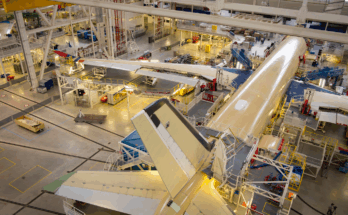by Richard Pettibone, Aerospace & Defense Companies Analyst, Forecast International.
With the Great Recession pretty much over, Embraer now finds itself stronger both financially and product line-wise. The company celebrated a record backlog of $20.9 billion in 2014, and deliveries have also gained strength.
As it seeks to continue this trend, the company has slowly expanded its operations around the world. Today, its global footprint includes its home in Brazil as well as operations in the U.S., China, Mexico, and Portugal. These facilities include not only pilot training and service centers but also business jet manufacturing operations. For example, in the U.S., the company assembles Phenom 100 and 300 aircraft (and soon the Legacy 450 and 500) in Melbourne, Florida; in China, the first Legacy 650 is being assembled; and in Portugal, the Evora facility manufactures wings. Such geographic dispersion insulates the company from single currency fluctuations. Perhaps more importantly, this diversity changes the mindset that Embraer is simply “a Brazilian company,” when in fact it has transitioned to an international aerospace firm.
In terms of markets, business jets are currently in the early stages of recovery. This recovery began in 2013, when annual business jet production registered a slight increase after having declined for four consecutive years. The recovery appears poised to strengthen in the next few years. Nevertheless, the outlook for strong growth remains muted. Even though businesses are reporting positive results, the stock market continues its bull run, and the number of millionaires increases, the lack of a willingness to invest in aircraft holds the market back. The key to unlocking this latent demand in the market is continued economic improvement, which should serve to strengthen business confidence and unlock corporate coffers.
The bizjet market runs the gamut from long-range and large-cabin aircraft to light- and medium-size jets. Thanks to aggressive development, Embraer now has a presence in seven of the eight business jet market segments. The company’s business jet line now covers each market segment from the very light jet (VLJ) class through the large-cabin category, and includes a product in the corporate-configured airliner class. Thanks to this wide product portfolio, Embraer is well positioned to capitalize on future growth should economic improvement continue.
The regional jet market was not as hard hit as the bizjet market following the 2008 crash. Further, this segment has gained momentum thanks to changes in the U.S. market. Orders in this segment surged following the relaxation in 2012 of scope clauses in major airline pilot contracts. The newly relaxed clauses permitted the operation of greater numbers of 76-seaters by the majors’ regional partners.
In response, regional aircraft have grown larger. Embraer’s E-Jets series – of which the large-passenger-capacity 190 and 195 are members – continues to be popular. In an effort to capitalize on the need for fuel efficiency, Embraer has launched the E2 series, a family of comprehensively upgraded versions of its E-Jets regional jets. The E2 aircraft feature new engines (the Pratt & Whitney PW100G) and landing gear, and possibly a new wing. Such a move follows the very successful trend set by Airbus and Boeing of introducing new fuel-efficient, re-engined designs in the A320neo and 737 MAX models. Both models are racking up impressive order numbers for their parent companies.
Looking ahead, another boom could materialize if scope clauses in the U.S. are further liberalized so that 90-seat or larger aircraft can be flown by the affected carriers. Outside the U.S., a combination of air traffic growth and the need for operating efficiency is driving carriers to acquire ever-larger aircraft to accommodate increasing numbers of passengers.
Embraer has also not been idle in its third market, defense and security.
The company is making considerable progress on its new KC-390 military tanker/transport. In May 2014, Embraer received a series production contract, valued at $3.3 billion, from the Brazilian Air Force for the KC‑390. Meanwhile, Embraer has secured letters of intent for 32 KC-390s from its five partner nations, broken down as follows: Argentina, six aircraft; Chile, six; Colombia, 12; the Czech Republic, two; and Portugal, six. The company has begun the process of converting these commitments into firm orders. At least initially, Embraer intends to build about 10 KC-390s per year.
In 2015, Saab and Embraer signed an agreement that establishes a partnership for joint management of the F-X2 Project for the Brazilian Air Force. The agreement concludes more than a year of negotiations since Brazil selected the Gripen NG fighter for the F-X2 contract in December 2013. Under the manufacturing plan, Embraer will receive a significant technology transfer package from Saab. The company will also be actively involved in finalizing the single-seat Gripen NG aircraft’s design and will develop with Saab the two-seat Gripen NG variant in Brazil. A production line will be set up at Embraer’s Gavião Peixoto industrial facility. With Brazil’s selection of the Gripen, Argentina has now expressed interest in possibly buying Embraer-built versions of the aircraft.
In non-aircraft programs, the $6 billion SISFRON system, for which Embraer was selected, is part of Brazil’s effort to boost security for the 2016 Olympic Games (the system was also used during preparations for the 2014 World Cup), and is to be completed by 2019. The SisGAAz system for the surveillance of the Blue Amazon could cost up to $4 billion. Both networks would establish multiple layers of surveillance coverage to help protect against Brazil’s principal security threats – smugglers, pirates, and criminal gangs – with existing assets supported by new satellites and unmanned aircraft systems.
Return to Forecast International homepage
A military history enthusiast, Richard began at Forecast International as editor of the World Weapons Weekly newsletter. As the Internet grew in importance as a research tool, he helped design the company's Forecast Intelligence Center and currently coordinates the EMarket Alert newsletters for clients. Richard also manages social media efforts, including two new blogs: Defense & Security Monitor, covering defense systems and international issues, and Flight Plan, which focuses on commercial aviation and space systems. For over 30 years, Richard has authored the Defense & Aerospace Companies, Volume I (North America) and Volume II (International) services. The two books provide detailed data on major aerospace and defense contractors. He also edits the International Contractors service, a database that tracks all the contractors involved in the programs covered in the FI library. More recently he was appointed Manager, Information Services Group (ISG), a new unit that encompasses developing outbound content for both Forecast International and Military Periscope.



